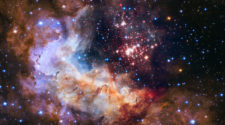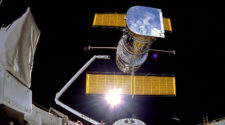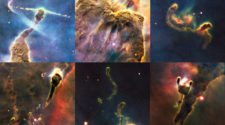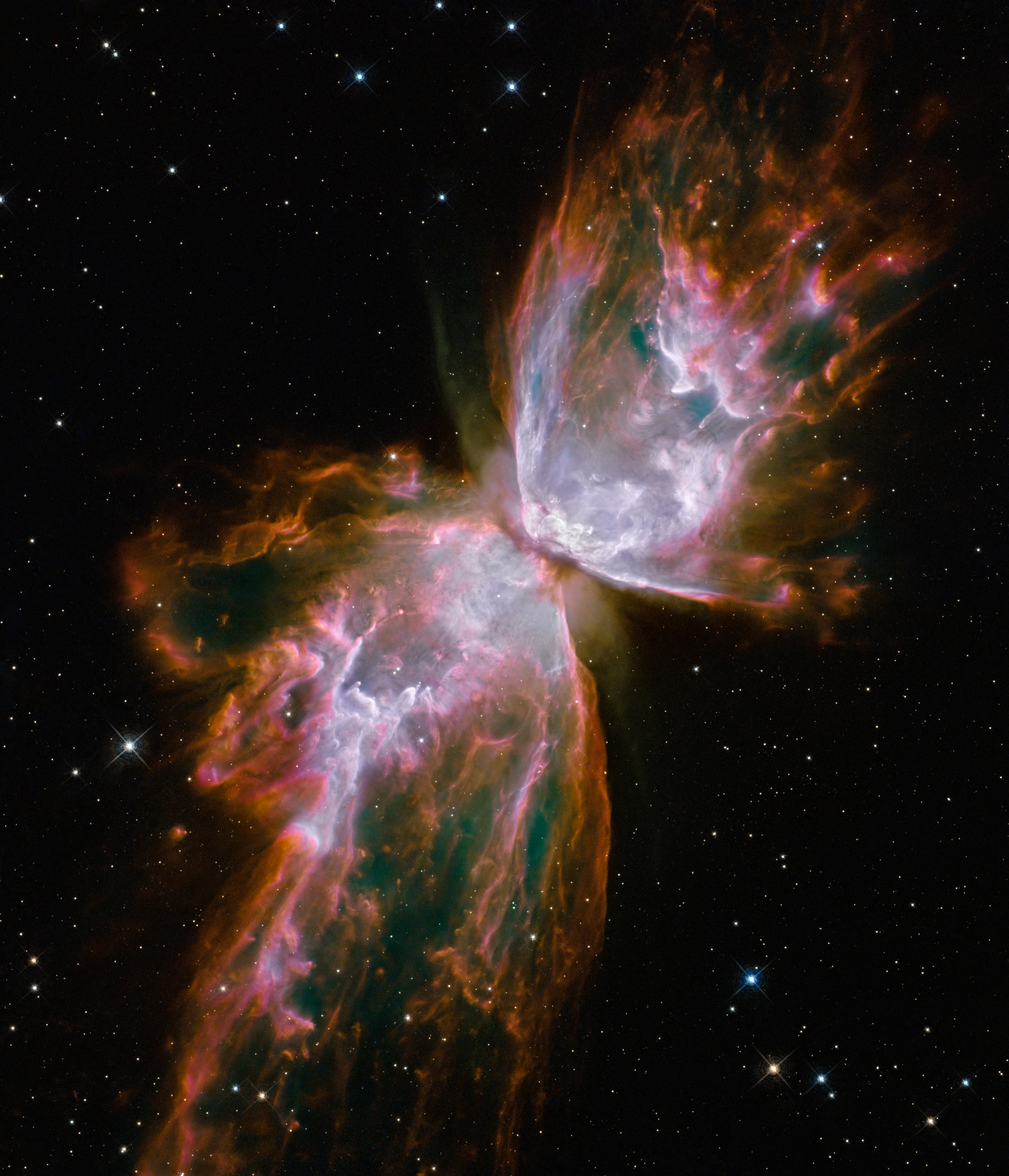
11. Butterfly emerges from stellar demise in planetary nebula
This celestial object looks like a delicate butterfly. But it is far from serene. What resemble dainty butterfly wings are actually roiling cauldrons of gas heated to nearly 20 000 degrees Celsius. The gas is tearing across space at more than 950 000 kilometres per hour — fast enough to travel from Earth to the Moon in 24 minutes!
A dying star that was once about five times the mass of the Sun is at the centre of this fury. It has ejected its envelope of gases and is now unleashing a stream of ultraviolet radiation that is making the cast-off material glow. This object is an example of a planetary nebula, so-named because many of them have a round appearance resembling that of a planet when viewed through a small telescope.
The Wide Field Camera 3 (WFC3) aboard the NASA/ESA Hubble Space Telescope, snapped this image of the planetary nebula, catalogued as NGC 6302, but more popularly called the Bug Nebula or the Butterfly Nebula.
NGC 6302 lies within our Milky Way galaxy, roughly 3800 light-years away in the constellation of Scorpius. The glowing gas is the star’s outer layers, expelled over about 2200 years. The “butterfly” stretches for more than two light-years, which is about half the distance from the Sun to the nearest star, Proxima Centauri.
The central star itself cannot be seen, because it is hidden within a doughnut-shaped ring of dust, which appears as a dark band pinching the nebula in the centre. The thick dust belt constricts the star’s outflow, creating the classic “bipolar” or hourglass shape displayed by some planetary nebulae.
The star’s surface temperature is estimated to be over 220 000 degrees Celsius, making it one of the hottest known stars in our galaxy. Spectroscopic observations made with ground-based telescopes show that the gas is roughly 20 000 degrees Celsius, which is unusually hot compared to a typical planetary nebula.
The WFC3 image reveals a complex history of ejections from the star. The star first evolved into a huge red giant, with a diameter of about 1000 times that of our Sun. It then lost its extended outer layers. Some of this gas was cast off from its equator at a relatively slow speed, perhaps as low as 32 000 kilometres per hour, creating the doughnut-shaped ring. Other gas was ejected perpendicular to the ring at higher speeds, producing the elongated “wings” of the butterfly-shaped structure. Later, as the central star heated up, a much faster stellar wind, a stream of charged particles travelling at more than 3.2 million kilometres per hour, ploughed through the existing wing-shaped structure, further modifying its shape.
The nebula’s reddish outer edges are largely due to light emitted by nitrogen, which marks the coolest gas visible in the picture. WFC3 is equipped with a wide variety of filters that isolate light emitted by various chemical elements, allowing astronomers to infer properties of the nebular gas, such as its temperature, density and composition.
The white-coloured regions are areas where light is emitted by sulphur. These are regions where fast-moving gas overtakes and collides with slow-moving gas that left the star at an earlier time, producing shock waves in the gas (the bright white edges on the sides facing the central star). The white blob with the crisp edge at upper right is an example of one of those shock waves.
NGC 6302 was imaged on 27 July 2009 with Hubble’s WFC3 in ultraviolet and visible light. Filters that isolate emissions from oxygen, helium, hydrogen, nitrogen and sulphur from the planetary nebula were used to create this composite image.

12. Hubble’s sharpest view of the Orion Nebula
This dramatic image offers a peek inside a cavern of roiling dust and gas where thousands of stars are forming. The image, taken by the Advanced Camera for Surveys (ACS) aboard the Hubble Space Telescope, represents the sharpest view ever taken of this region, called the Orion Nebula. More than 3,000 stars of various sizes appear in this image. Some of them have never been seen in visible light. These stars reside in a dramatic dust-and-gas landscape of plateaus, mountains, and valleys that are reminiscent of the Grand Canyon.
The Orion Nebula is a picture book of star formation, from the massive, young stars that are shaping the nebula to the pillars of dense gas that may be the homes of budding stars. The bright central region is the home of the four heftiest stars in the nebula. The stars are called the Trapezium because they are arranged in a trapezoid pattern. Ultraviolet light unleashed by these stars is carving a cavity in the nebula and disrupting the growth of hundreds of smaller stars. Located near the Trapezium stars are stars still young enough to have disks of material encircling them. These disks are called protoplanetary disks or “proplyds” and are too small to see clearly in this image. The disks are the building blocks of solar systems.
The bright glow at upper left is from M43, a small region being shaped by a massive, young star’s ultraviolet light. Astronomers call the region a miniature Orion Nebula because only one star is sculpting the landscape. The Orion Nebula has four such stars. Next to M43 are dense, dark pillars of dust and gas that point toward the Trapezium. These pillars are resisting erosion from the Trapezium’s intense ultraviolet light. The glowing region on the right reveals arcs and bubbles formed when stellar winds – streams of charged particles ejected from the Trapezium stars – collide with material.
The faint red stars near the bottom are the myriad brown dwarfs that Hubble spied for the first time in the nebula in visible light. Sometimes called “failed stars,” brown dwarfs are cool objects that are too small to be ordinary stars because they cannot sustain nuclear fusion in their cores the way our Sun does. The dark red column, below, left, shows an illuminated edge of the cavity wall.
The Orion Nebula is 1,500 light-years away, the nearest star-forming region to Earth. Astronomers used 520 Hubble images, taken in five colours, to make this picture. They also added ground-based photos to fill out the nebula. The ACS mosaic covers approximately the apparent angular size of the full moon.
The Orion observations were taken between 2004 and 2005.
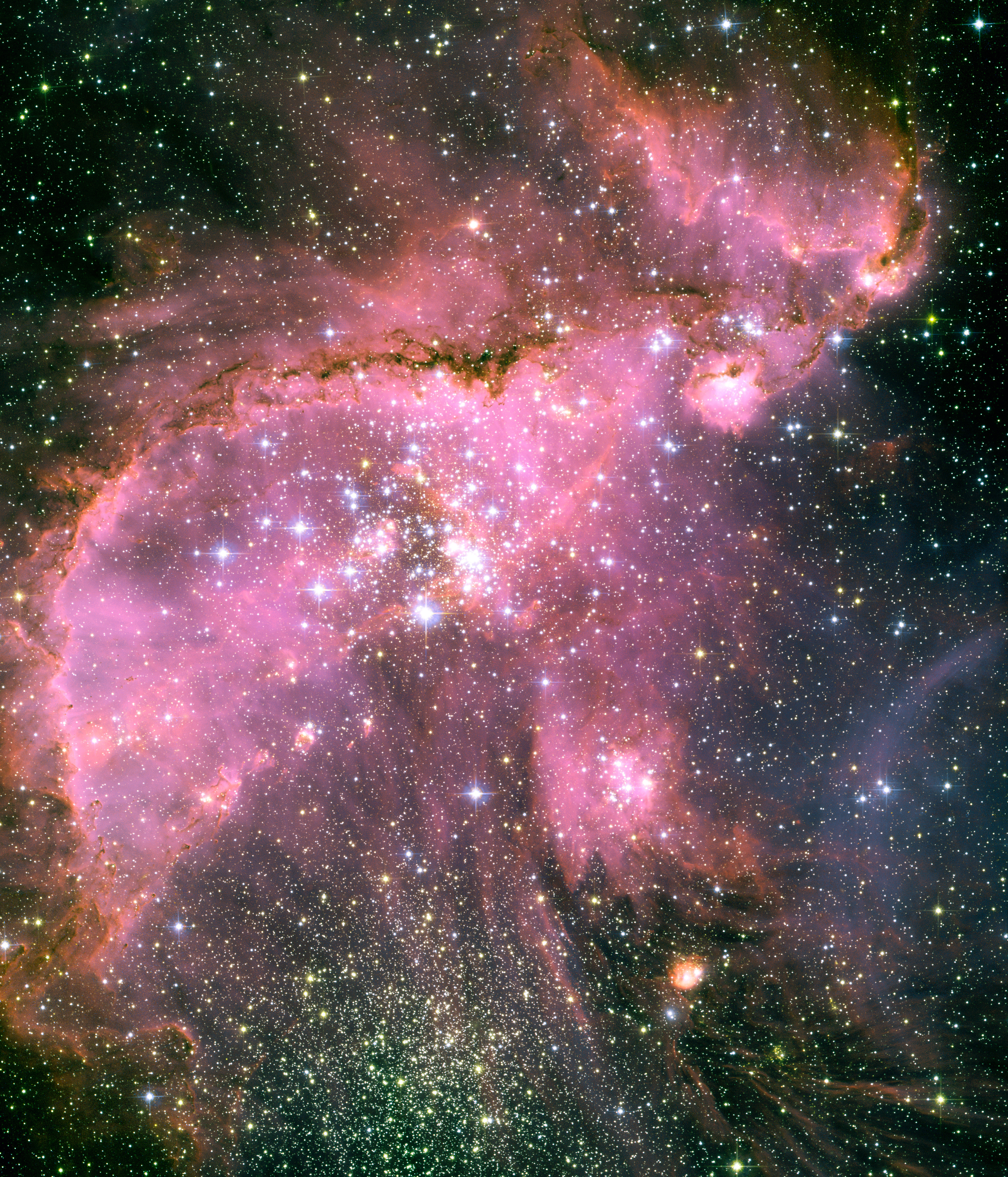
13. Young stars sculpt gas with powerful outflows
This Hubble Space Telescope view shows one of the most dynamic and intricately detailed star-forming regions in space, located 210,000 light-years away in the Small Magellanic Cloud (SMC), a satellite galaxy of our Milky Way. At the centre of the region is a brilliant star cluster called NGC 346. A dramatic structure of arched, ragged filaments with a distinct ridge surrounds the cluster.
A torrent of radiation from the hot stars in the cluster NGC 346, at the centre of this Hubble image, eats into denser areas around it, creating a fantasy sculpture of dust and gas. The dark, intricately beaded edge of the ridge, seen in silhouette, is particularly dramatic. It contains several small dust globules that point back towards the central cluster, like windsocks caught in a gale.
“After my PhD I spent three years at the Space Telescope Science Institute which is responsible for all the science operations with Hubble. This was a very exciting time. Especially during a certain week in the year, the week right before the proposal deadline, when all astronomers write what amazing science they would like to do with Hubble. In Baltimore, where nearly everyone uses Hubble, this week is crazy. Getting time on Hubble is very hard. Only 1 out of every 8 proposals gets time. And it takes a lot of effort to write a proposal.
“The weeks before, the Institute seems to be buzzing. People are excited to discuss wild ideas, brainstorm with each other how the instruments can be used to get the most out of it. For many it is a very stressful period, where most people barely get any sleep. But the intensity and passion people have for their work is very hard to describe and it really struck me.
“One of the better memories is of the colleague who would order many pizzas to support everyone who was still working on improving their proposals. If you realize how hard it is to get time and how competitive it is, it is very special to feel that supportive atmosphere in the Institute. People just want to amazing science with Hubble. That week they seem to give everything for it.”
Dr. Selma E. de Mink
Assistant Professor
University of Amsterdam
Netherlands
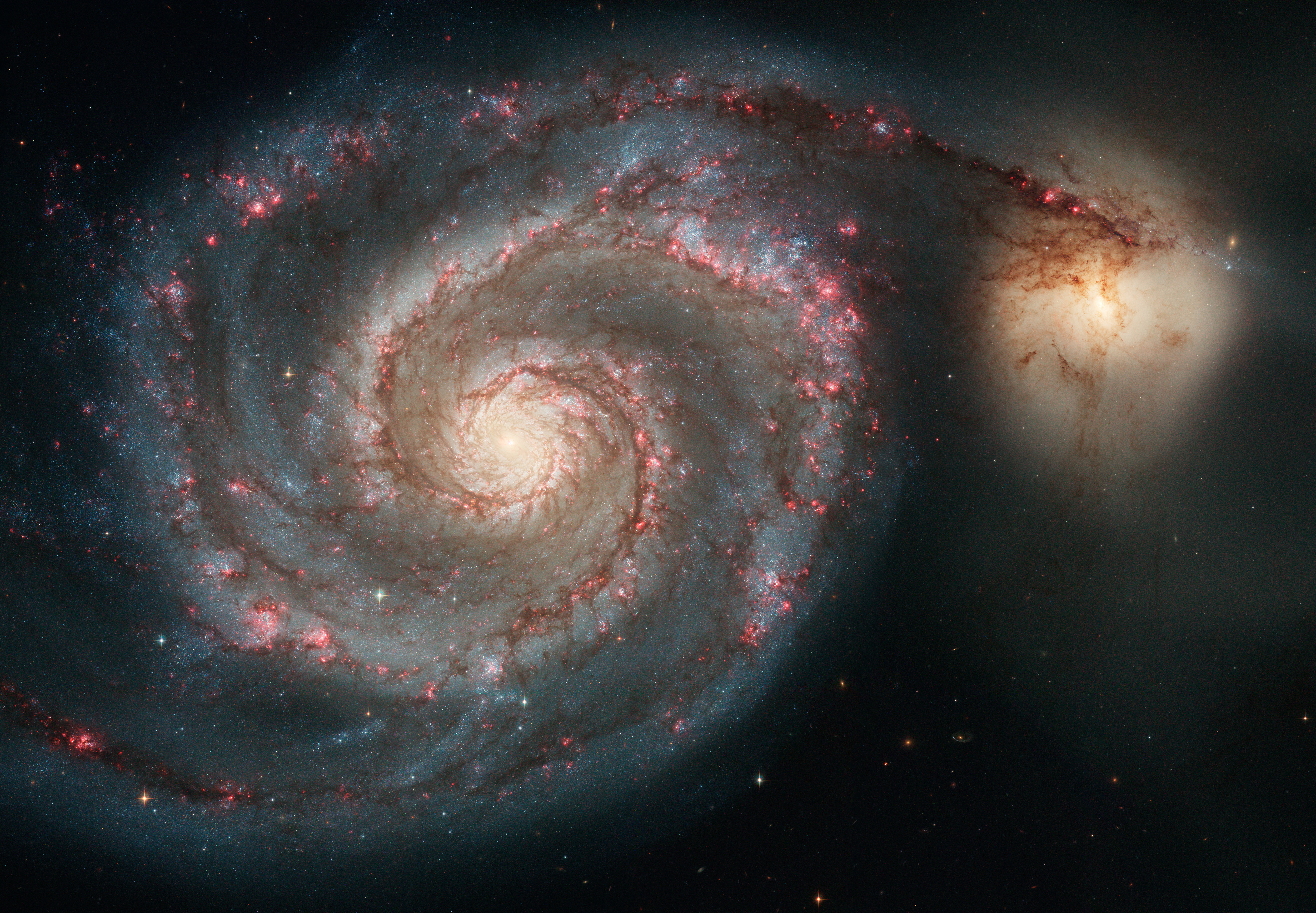
14. Out of this whirl: Whirlpool galaxy (M51) and companion galaxy
The graceful, winding arms of the majestic spiral galaxy M51 (NGC 5194) appear like a grand spiral staircase sweeping through space. They are actually long lanes of stars and gas laced with dust.
This sharpest-ever image, taken in January 2005 with the Advanced Camera for Surveys aboard the Hubble Space Telescope, illustrates a spiral galaxy’s grand design, from its curving spiral arms, where young stars reside, to its yellowish central core, a home of older stars. The galaxy is nicknamed the Whirlpool because of its swirling structure.
The Whirlpool’s most striking feature is its two curving arms, a hallmark of so-called grand-design spiral galaxies. Many spiral galaxies possess numerous, loosely shaped arms that make their spiral structure less pronounced. These arms serve an important purpose in spiral galaxies. They are star-formation factories, compressing hydrogen gas and creating clusters of new stars. In the Whirlpool, the assembly line begins with the dark clouds of gas on the inner edge, then moves to bright pink star-forming regions, and ends with the brilliant blue star clusters along the outer edge.
The Whirlpool is one of astronomy’s galactic darlings. Located approximately 25 million light-years away in the constellation Canes Venatici (the Hunting Dogs), the Whirlpool’s beautiful face-on view and closeness to Earth allow astronomers to study a classic spiral galaxy’s structure and star-forming processes.

15. Stellar spire in the Eagle Nebula
Appearing like a winged fairy-tale creature poised on a pedestal, this object is actually a billowing tower of cold gas and dust rising from a stellar nursery called the Eagle Nebula. The soaring tower is 9.5 light-years or about 90 trillion kilometres high, about twice the distance from our Sun to the next nearest star.
Stars in the Eagle Nebula are born in clouds of cold hydrogen gas that reside in chaotic neighbourhoods, where energy from young stars sculpts fantasy-like landscapes in the gas. The tower may be a giant incubator for those newborn stars. A torrent of ultraviolet light from a band of massive, hot, young stars [off the top of the image] is eroding the pillar.
The starlight also is responsible for illuminating the tower’s rough surface. Ghostly streamers of gas can be seen boiling off this surface, creating the haze around the structure and highlighting its three-dimensional shape. The column is silhouetted against the background glow of more distant gas.
Inside the gaseous tower, stars may be forming. Some of those stars may have been created by dense gas collapsing under gravity. Other stars may be forming due to pressure from gas that has been heated by the neighbouring hot stars.
The bumps and fingers of material in the centre of the tower are examples of these stellar birthing areas. These regions may look small but they are roughly the size of our solar system.
The dominant colours in the image were produced by gas energized by the star cluster’s powerful ultraviolet light. The blue colour at the top is from glowing oxygen. The red color in the lower region is from glowing hydrogen. The Eagle Nebula image was taken in November 2004 with the ACS aboard Hubble.
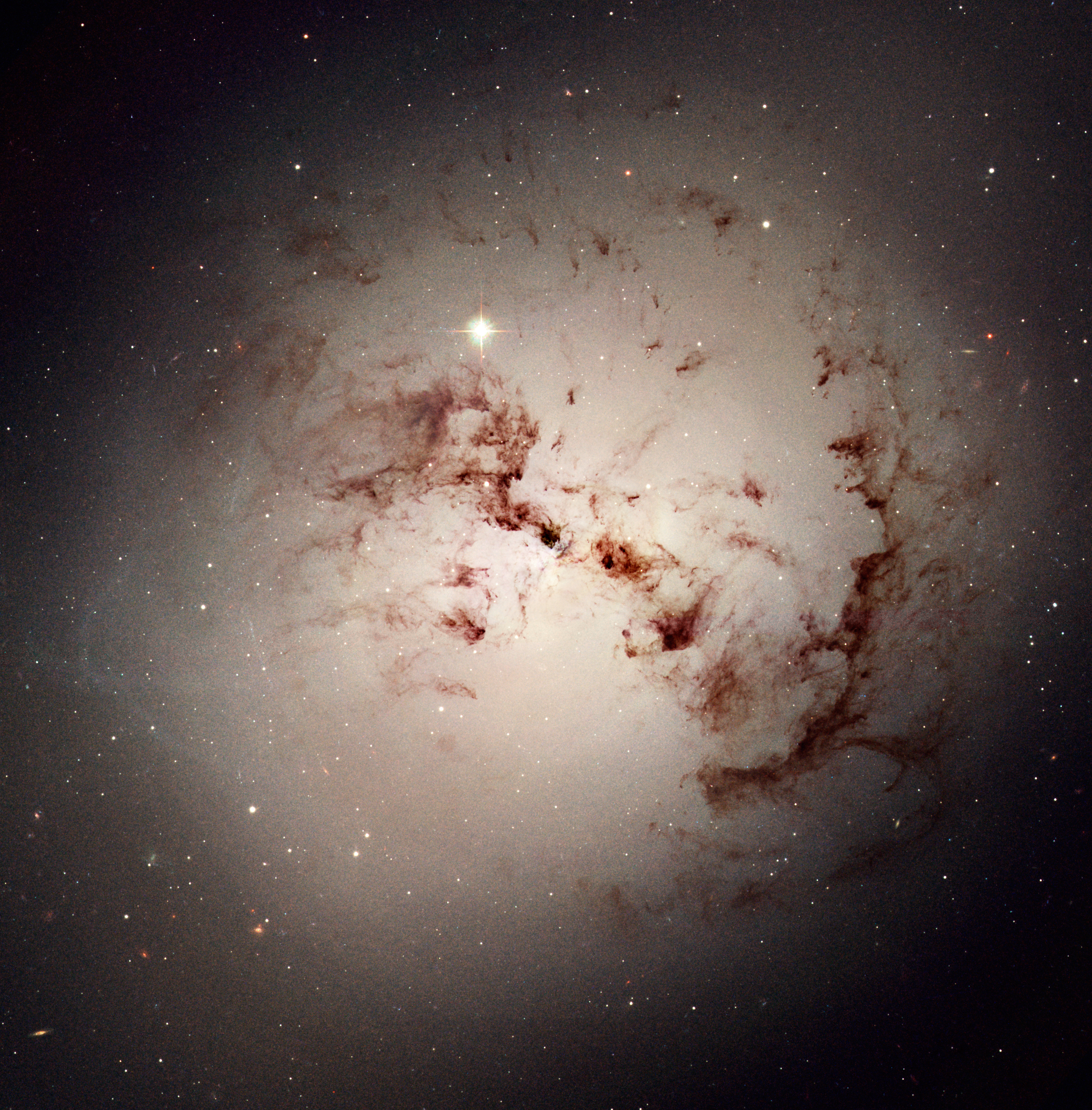
16. Cosmic dust bunnies
Like dust bunnies that lurk in corners and under beds, surprisingly complex loops and blobs of cosmic dust lie hidden in the giant elliptical galaxy NGC 1316. This image made from data obtained with Hubble reveals the dust lanes and star clusters of this giant galaxy that give evidence that it was formed from a past merger of two gas-rich galaxies.
“The Hubble Space Telescope has revolutionized astronomy in many ways. As beautifully illustrated by the Top 100 gallery, it has produced thousands of stunning pictures giving us a sharper view to the universe than ever before, and allowing for unprecedented insights into the cosmos.
“In every area of astronomy HST has made discovery that were completely unanticipated during its planning stages. This is a true sign of a revolutionary observatory. For example, in one of my areas of interest, gravitational lensing, HST has been transformative. With its superb angular resolution it has allowed astronomers to transform what was thought to be a mere curiosity with no chances of ever been observed (including by Einstein’s himself!) into a workhorse for cosmology.
“With Hubble and gravitational lensing we have learned about the first galaxies ever to form in the universe, and we have learned about the fundamental nature of dark matter and dark energy, just to name a couple of topics. Recent examples of gravitational lensing work that I have been involved in are the discovery of the multiply imaged supernova ‘Refsdal’ and of the first double Einstein Ring.
“On a more personal level, HST has transformed my life as well. It was after an undergraduate summer research experience at the Space Telescope Science Institute that I decided to go to graduate school in physics and pursue a career as an astrophysicist.”
Tommaso Treu
Professor
University of California, Los Angeles
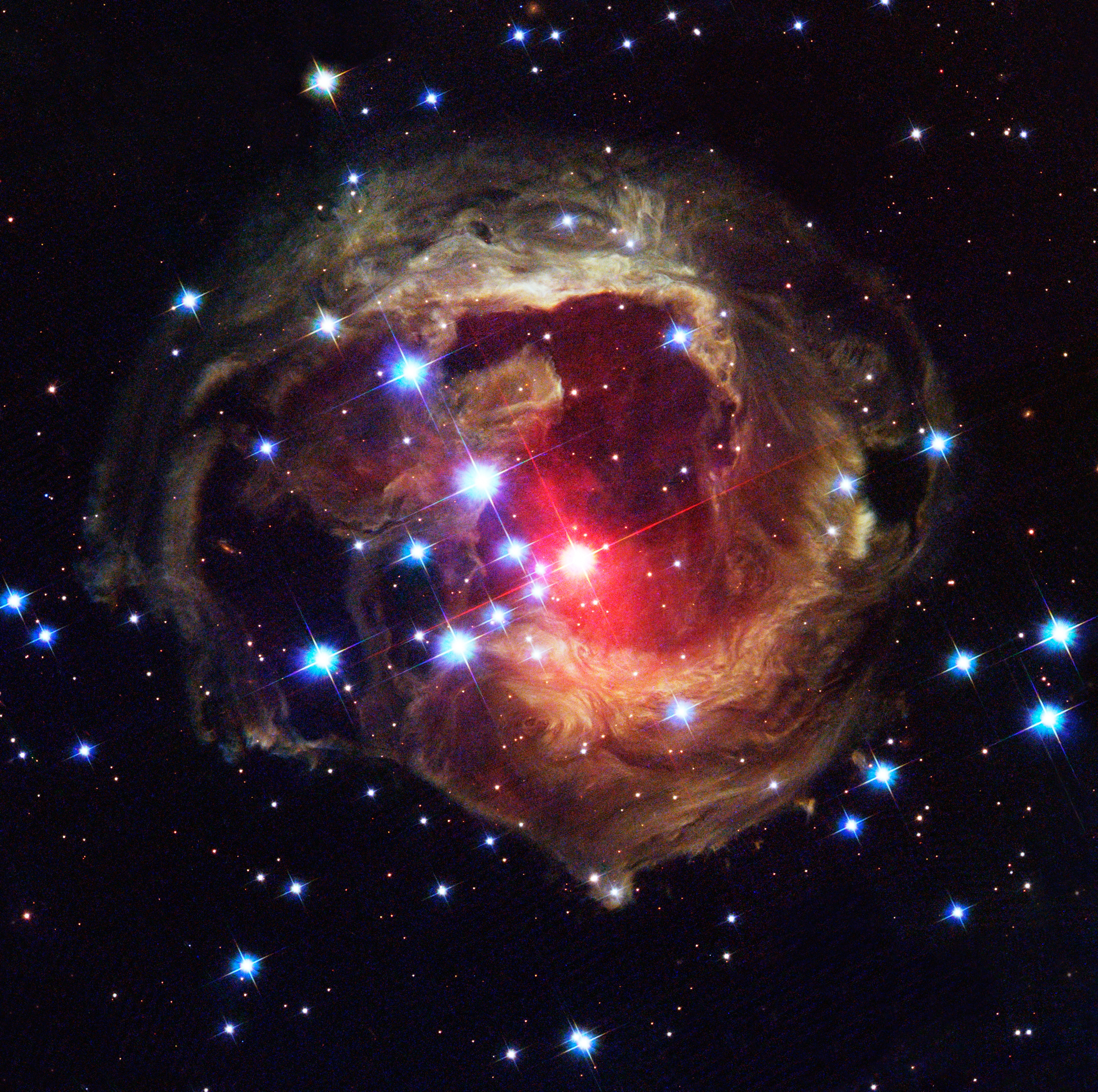
17. Light continues to echo three years after stellar outburst
This Hubble image of the star V838 Monocerotis (V838 Mon) reveals dramatic changes in the illumination of surrounding dusty cloud structures. The effect, called a light echo, has been unveiling never-before-seen dust patterns ever since the star suddenly brightened for several weeks in early 2002.
“With a superior resolving power to most other telescopes and the unobscured view of the universe from above our atmosphere, Hubble takes truly beautiful, unique images of the cosmos.”
Dr. Katherine E. Whitaker
NASA Postdoctoral Program Fellow
Goddard Space Flight Center
Greenbelt, Maryland
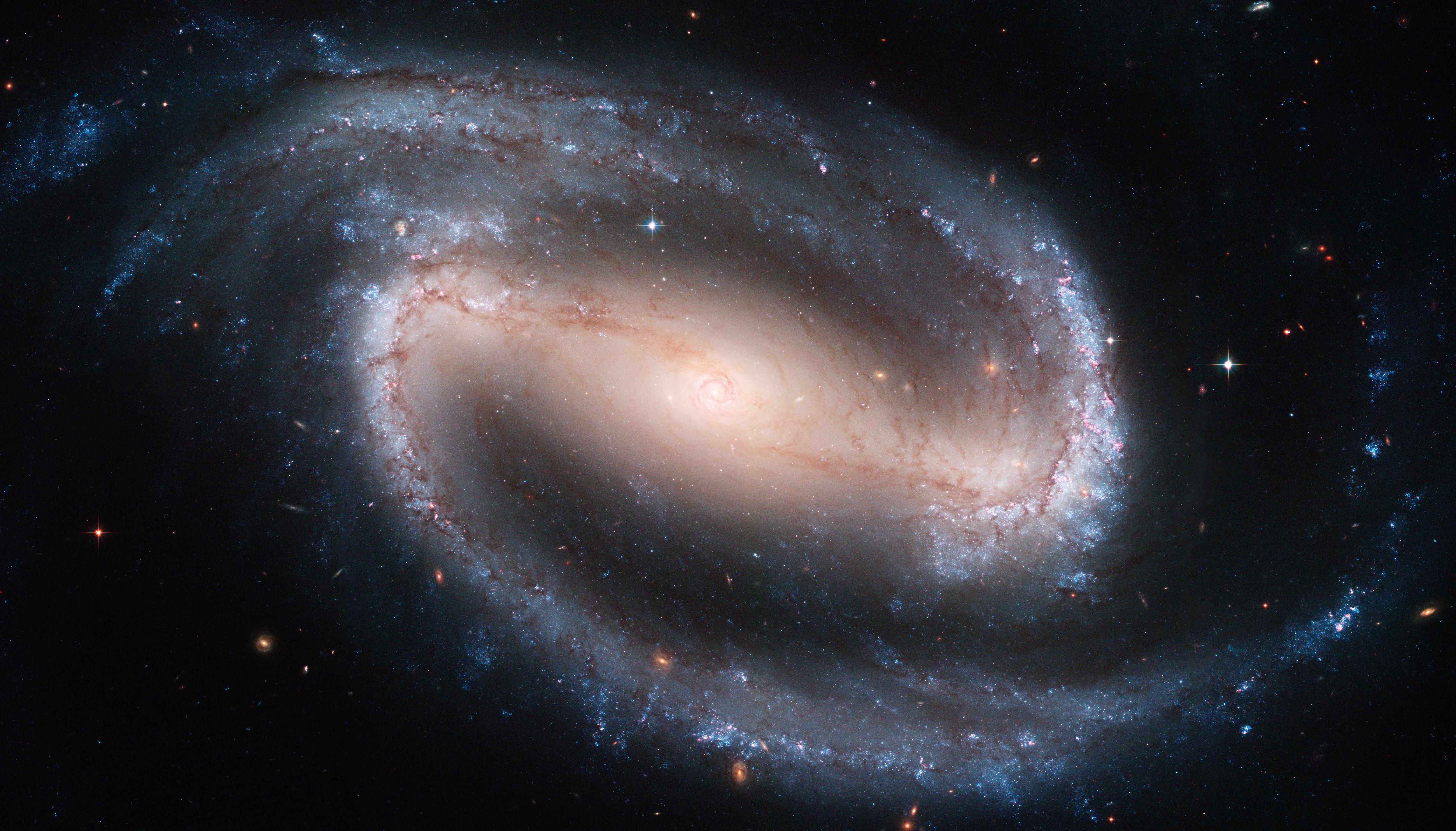
18. Beautiful barred spiral galaxy NGC 1300
One of the largest Hubble Space Telescope images ever made of a complete galaxy was unveiled at the American Astronomical Society meeting in San Diego, Calif.
The Hubble telescope captured a display of starlight, glowing gas, and silhouetted dark clouds of interstellar dust in this 4-foot-by-8-foot image of the barred spiral galaxy NGC 1300. NGC 1300 is considered to be prototypical of barred spiral galaxies. Barred spirals differ from normal spiral galaxies in that the arms of the galaxy do not spiral all the way into the center, but are connected to the two ends of a straight bar of stars containing the nucleus at its center.
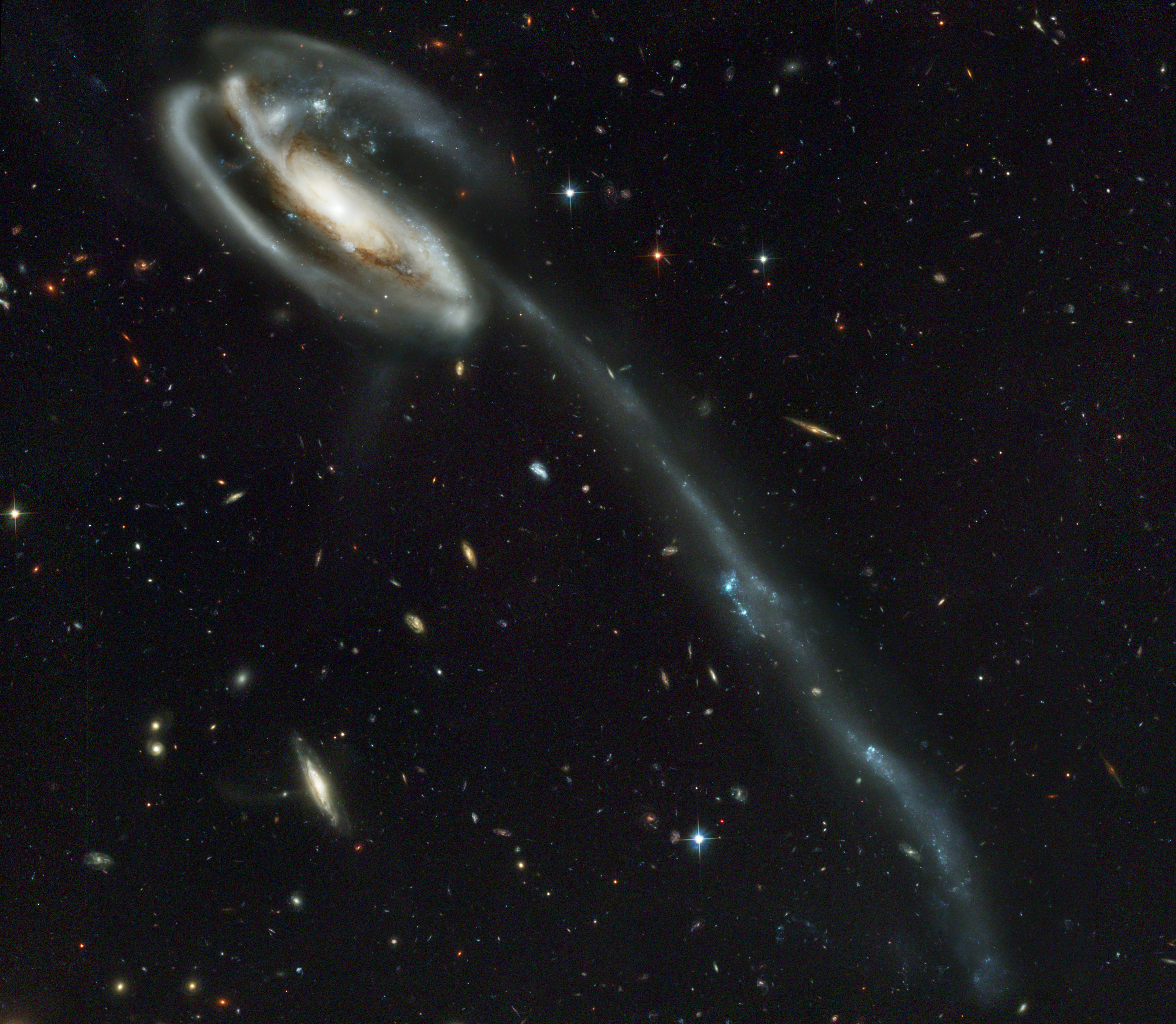
19. A runaway galaxy
Against a stunning backdrop of thousands of galaxies, this odd-looking galaxy with the long streamer of stars appears to be racing through space, like a runaway pinwheel firework.
Galaxy UGC 10214’s distorted shape was caused by a small interloper, a very blue, compact, galaxy visible in the upper left corner of the more massive Tadpole. The Tadpole resides about 420 million light-years away in the constellation Draco.
Numerous young blue stars and star clusters, spawned by the galaxy collision, are seen in the spiral arms, as well as in the long ‘tidal’ tail of stars. Each of these clusters represents the formation of up to about a million stars. Two prominent clumps of young bright blue stars are visible in the tidal tale and separated by a gap. These clumps of stars will likely become dwarf galaxies that orbit in the Tadpole’s halo.
Behind the galactic carnage and torrent of star birth is another compelling picture: a ‘wallpaper pattern’ of about 3000 faint galaxies. The camera’s vision is so sharp that astronomers can identify distant colliding galaxies, the ‘building blocks’ of galaxies, an exquisite ‘Whitman’s Sampler’ of normal galaxies, and presumably extremely faraway galaxies.
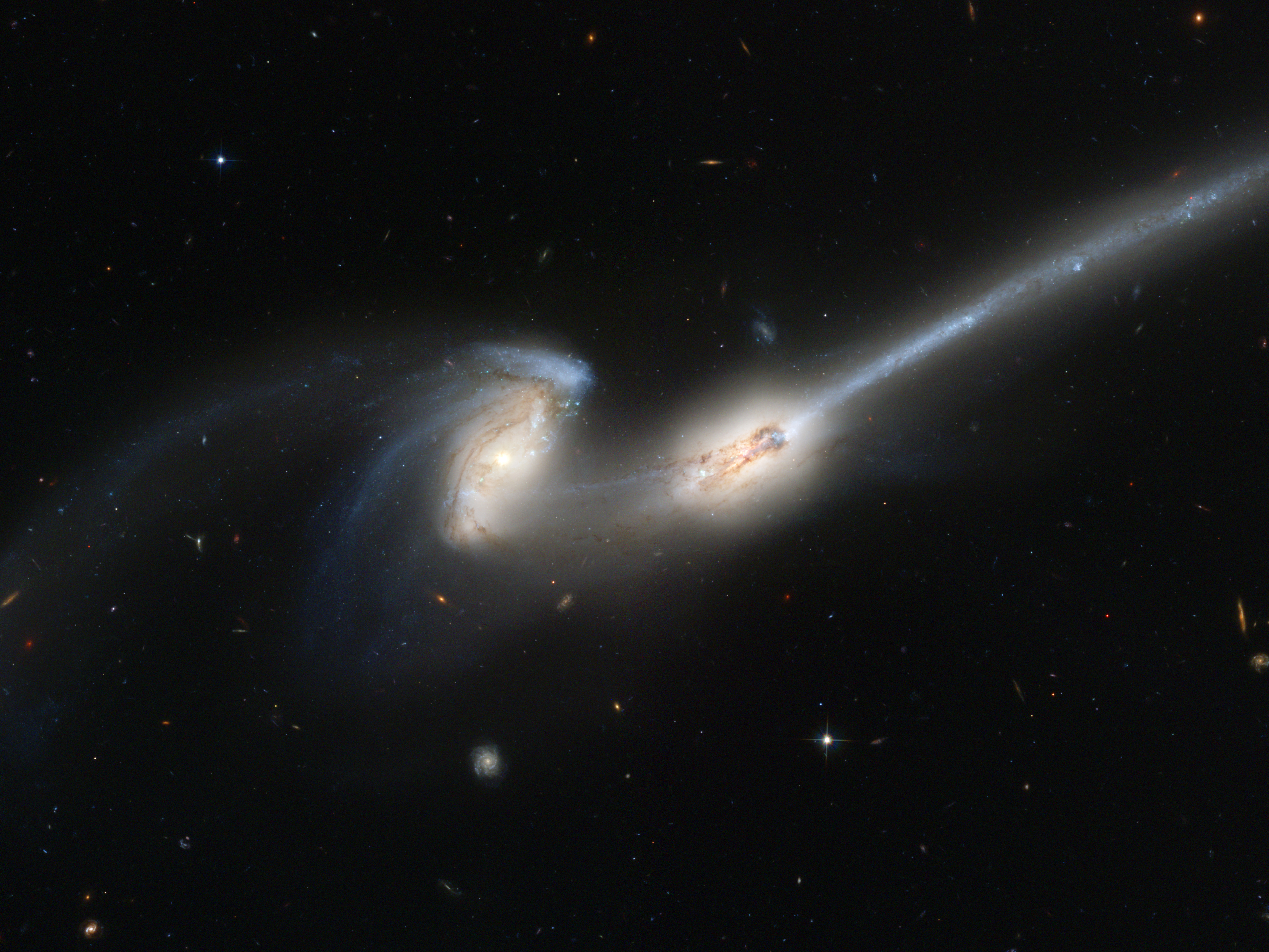
20. A deep look at two merging galaxies
The Advanced Camera for Surveys (ACS) aboard Hubble captured a spectacular pair of galaxies engaged in a celestial dance of cat and mouse or, in this case, mouse and mouse.
Located 300 million light-years away in the constellation Coma Berenices, the colliding galaxies have been nicknamed “The Mice” because of the long tails of stars and gas emanating from each galaxy. Otherwise known as NGC 4676, the pair will eventually merge into a single giant galaxy.

